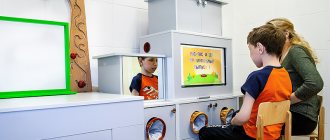Modern methods and technologies of musical education of preschool children in the context of the implementation of the Federal State Educational Standard for Education
Tashkinova E.N. Modern methods and technologies of musical education of preschool children in the context of the implementation of the Federal State Educational Standard for Education // Sovushka. 2020. No. 3(5). URL: https://kssovushka.ru/zhurnal/5/ (access date: 10.10.2020).
The purpose of any type of art is to reflect reality in its artistic images, and how a child learns to perceive them, think about them, decode the idea of an artist, composer, writer, director depends on the work of each specialist and educator.
Music occupies a special, unique place in the education of preschool children. This is explained by the specifics of this type of art and the psychological characteristics of preschoolers. Music reflects a person’s attitude to the whole world, to everything that happens around and in the person himself. Primary musical education is designed to play a very important role in a person’s life. Music and children's musical activity are a means and condition for a child's entry into the world of social relations. The range of tasks of musical education and child development in preschool childhood under the conditions of the Federal State Educational Standard for Education has expanded. Music acts as one of the possible languages for introducing children to the world around them, the world of objects and nature and, most importantly, the world of man, his emotions, experiences and feelings. Modern preschool pedagogy is aimed at finding innovative approaches to raising and teaching preschool children.
The use of innovative methods and forms, techniques and technologies in music education under the conditions of the introduction of the Federal State Educational Standard became the goal of my work.
I implement the goal in tasks that meet the urgent needs of the child:
- creating conditions that provide opportunities for each child to demonstrate their individual abilities when communicating with music;
- creative development of the child’s natural musicality;
- releasing primary creativity, creating conditions for spontaneous creative manifestations;
- assistance in the formation of the inner world and self-knowledge (emotional and mental development and psychocorrection).
The main principle that guides my work is attention to each child: taking into account his age, speech, individual musical characteristics and needs. There are a number of other principles that I adhere to in music classes:
- The musical director is an equal partner. He knows how to play interestingly, organizes games, invents them.
- Freedom and independence in children’s choice of knowledge, skills and abilities.
- Freedom does not mean permissiveness, it is the subordination of one’s actions to general rules.
- Focus on individual discovery. Children should be made partners in a game or idea.
New approaches to music education required the use of completely different, most effective pedagogical technologies in the development of children's musicality.
The path to music must be justified from a person's point of view, and proceed from it. In this regard, when choosing the forms and methods of musical and artistic activity, it became necessary to direct them to the development in children: the ability to sense the world and observe it; associativity of artistic thinking; expressiveness of intonation: speech, vocal, plastic plastic instrumental.
The basis of innovative technologies for musical education of children is collective activity, combining: singing, rhythmic speech, playing children's musical instruments, dancing, improvised movement to music, voicing poems and fairy tales, pantomime, improvised theatrical performance.
The forms of musicality development that I use in practice are:
Communicative dances
Involving a child in the process of playing music lies through creating an atmosphere of acceptance of each other and emotional and mental emancipation. Here, communicative dances are indispensable assistants, the use of which solves the following problems:
developing communication skills, working on a sense of form,
development of motor coordination, development of a sense of rhythm.
Coordination and movement games (musical and speech)
Such games on a large scale (through the whole body) give a sense of musical dynamics, tempo, performance touch, speech and plastic intonation, which is their musical content.
These games are permeated with the idea of coordination, which acts in them as a motor “accompaniment”, stimulates the development of dexterity, accuracy, reaction, and fosters ensemble coherence.
Finger games (musical and speech)
The value of finger games in the context of the development of children's musicality lies in the fact that they represent the first experiences of performing artistry, in which the character of the performance is actually intoned, enriched with rhythmic and sound modulations of spoken language.
"Chorus of Hands"
This form is interesting in that it leads children to an understanding of motor two-voices, in which all participants are divided into a “chorus of two voices” and two leaders—“conductors.” This form is aimed at developing
coordination freedom of movement, sense of rhythm, attention, ensemble coherence, ability for motor improvisation.
Rhythmic recitation to music
Rhythmic declamation is a synthesis of music and poetry. It can be defined as a musical pedagogical model in which the text is not sung, but rhythmically recited.
Games with sounds
When working with games with sounds, I roughly highlight the following areas:
- sounding gestures and music of my body;
— noise instruments (traditional and homemade) and music born from noise.
Elementary music playing
In musical activities with children, I consider it necessary to use children's musical instruments, primarily noise instruments, since these instruments are simple and most accessible to children of this age. But this form of work on the development of musicality is not limited to the use of traditional noise instruments. In modern musical methodology, it is the study of sound and children’s knowledge of the world through sound, the creation of a different image of a wide variety of everyday objects that are increasingly being developed. They are the members of an amazing orchestra!
Communication between children and primary instruments develops: musicality, timbre hearing, subtlety of perception, associativity, and artistry.
Taking into account the new requirements for the interaction of preschool educational institutions with families, I decided to introduce new forms of work with parents into my work in order to develop the musical abilities of preschool children.
I organize the involvement of parents in the musical and educational space of preschool educational institutions in several directions: increasing competence in matters of musical education of children (individual conversations, consultations, seminars); involvement in the musical educational process (open classes, participation in them); joint cultural and leisure activities (writing scripts, participating in the preparation and holding of holidays, playing roles).
My students get to know themselves and the world around them in the process of playful, joyful and natural communication with music, without unnecessary “training” and tedious memorization; educational tasks are carried out along the way, the predominant tasks are education and development, as provided for by the Federal State Educational Standard for Education.
Literature:
- Burenina A.I. Rhythmic mosaic is a rhythmic plasticity program for children. St. Petersburg, 2000.
- Kartushina M.Yu. Fun for kids - theatrical entertainment. M., 2008.
- Kostina E.P. Tuning fork is a music education program for children of early and preschool age. M., 2008
- Musical Director - illustrated methodological magazine. M., 2004.
- Poddubnaya E.A. Musical finger games. M., 2006.
- Radynova O.P. Musical masterpieces - a music education program. M., 2006.
Lecture 3. Types of musical activities in preschool educational institutions
The issues of organizing children's musical activity were developed by psychologists, musicologists, and teachers: E. V. Nazaikinsky, B. V. Asafiev, N. A. Vetlugina, O. P. Radynova, A. G. Gogoberidze, A. N. Zimina, etc.
According to the definition of O.P. Radynova, the musical activity of preschoolers is various ways and means of children’s knowledge of musical art, with the help of which the musical and general development of the child is carried out.
In the musical education of children, the following types of musical activities are distinguished: listening to music, performing (singing, musical-rhythmic movements, playing children's musical instruments), children's musical creativity and music-educational activities.
Listening to music is an active internal process of concentration, which gives children the opportunity to perceive and understand various types and genres of musical art.
. Vocal music has a great influence on children, because it is based on the unity of music and literary texts. It is more difficult for children to understand instrumental music, which is why it is so important for the teacher to methodically and competently convey to the consciousness of preschoolers its musical image and mood. Listening to music contributes to the development of musical abilities, melodic, harmonic, rhythmic and timbre hearing, and also deepens children's understanding of the environment and helps in the formation of the intelligence of preschoolers.
Forms of listening to music: 1) listening to music in the process of all musical work with them - in singing, musical-rhythmic movements, musical-didactic games, playing instruments.
So, before starting to learn a song, dance or melody on a metallophone with children, children are invited to listen and comprehend the music that they will perform.
2) Special listening to music in music classes. 3) Independent lesson in listening to music with children of senior preschool age. 4) Listening to music at leisure evenings and holidays.
Performing activities involve children performing songs, dancing and playing children's musical instruments.
In the process of learning to sing, children develop singing skills and abilities, develop an ear for music and a singing voice. It is important to teach children to perform songs in class and at home, with the help of a teacher and independently, with or without the accompaniment of an instrument. Children of senior preschool age should be able to clearly intonate and expressively convey the character of the melody, sing with clear diction, observing the rules of ensemble singing.
Teaching preschoolers musical and rhythmic skills should be carried out through games, dances and exercises. The teacher teaches children to coordinate movements with the character and rhythm of the music.
When playing musical instruments, it is important that children master the techniques of playing them, become interested in selecting melodies by ear on a metallophone and other instruments, and be able to play individually and in an ensemble.
Children's musical creativity includes compositions and improvisations: songs, dances, instrumentals. The criterion for the success of children's musical creativity is emotionality, expressiveness, and originality of improvisation. Creative tasks should be used in classes throughout preschool childhood, for example, children are asked to: sing your name, sing the song of a mother cat who lulls kittens to sleep; older children are asked to compose a melody for a nursery rhyme, a quatrain and other tasks.
Musical educational activity is the acquisition of basic knowledge about music and musical activity. In the process of listening to music, learning songs, dancing, playing musical instruments, children gain knowledge about the nature of the musical image, about the composer who wrote this piece of music, about the era in which he lived, about the musical instruments of the symphony and folk orchestra, etc. Information about music and its expressive means deepen perception, help more accurately depict the image and mood in singing, movement or playing musical instruments.
Thus, the development of musical abilities and the foundations of children’s musical culture is carried out through all types of musical activities: listening to music, performing, creativity and music-educational activities.
Previous4Next





